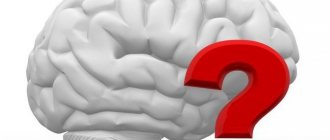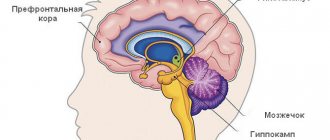General information
This form of amnesia was first described by the Russian psychiatrist S.S. Korsakov, who, while studying severe alcohol poisoning, drew attention to the severe memory impairment observed in patients.
The combination of severe anterograde and retrograde amnesia that occurs with alcohol poisoning, after the publication of Korsakov’s work “On Alcoholic Paralysis” in 1887, entered the scientific literature under the name “Korsakov syndrome.”
In 1900, V. M. Bekhterev described paroxysmal retrograde amnesia. Bekhterev identified this type of amnesia in a patient who had suffered a stroke, so he considered this type of memory impairment as a syndrome of epileptiform origin (arising as a result of organic brain damage).
Forms
Retrograde amnesia is divided into:
- Partial, in which fragments of events and vague images are preserved in memory, but the spatial and temporal characteristics are disrupted.
- Complete, in which all memories relating to a certain period of time are completely lost.
- Temporary, which is caused by traumatic brain injury or is a consequence of electroconvulsive therapy. With this form, the patient cannot reproduce events that took place before the injury (“failure” from memory can take seconds or months, depending on the severity of the injury).
- Constant. Occurs with long-term use of electroconvulsive therapy, stroke, damage to cerebral vessels due to encephalitis, etc.
Depending on the cause of memory loss, retrograde amnesia is divided into:
- organic (occurs with head trauma, organic brain diseases, alcoholism and poisoning);
- psychological (psychogenic), in which memories of mental trauma are repressed from memory.
Depending on the course of the pathological process, retrograde amnesia can be:
- Spicy. Develops suddenly as a consequence of traumatic brain injury, stroke, herpetic encephalitis, metabolic encephalopathies and intoxication.
- Gradually increasing (observed in degenerative brain diseases, tumors and some mental illnesses).
Classification - unconsciousness comes in different forms
The types of amnesia can be classified according to several criteria, depending on the rate of its development, the following types are distinguished:
- Regressive . Characterized by the gradual recovery of forgotten memories. This type occurs in people who have suffered from traumatic brain injuries, concussions, or have recently recovered from anesthesia.
- Stationary . In this case, individual events are deleted from memory. This process is persistent, without change, that is, a person forgets certain events from his life and does not remember them again. The causes of this type of disorder can be senile dementia, psychological trauma, and head trauma.
- Progressive . Memories are removed from memory gradually, starting from recent ones and ending with long-past events. This type of amnesia is characterized by clearer preservation of childhood and youth memories, as well as professional skills and abilities. This kind of memory impairment is caused by brain tumors and mental illnesses.
Amnesia is also classified depending on the moment at which individual memories were lost:
- Retrograde . This is a pathological condition in which a person’s memory “falls out” of events that occurred before the development of the disease or injury that provoked amnesia. At the same time, facts and events that occurred in the distant past are preserved, especially if they have great emotional significance for the victim. Retrograde amnesia develops due to cerebral circulation disorders, traumatic brain injuries, stressful situations, and deep emotional upheavals.
- Anterograde . This condition is characterized by the loss of events that occurred after the disease causing amnesia developed or after receiving a severe head injury. This type of memory impairment occurs in old age, after traumatic brain injury and infectious diseases, and in the presence of mental disorders.
- Anteroretrograde . As the name indicates, this type of amnesia combines the features of the first and second types described above and occurs after particularly severe head injuries. As a rule, certain events preceding the turning point and some events following it are forgotten.
- Retarded, or delayed . In this case, memory impairments do not appear immediately, but only some time after the turning point. May occur against the background of acute psycho-emotional shocks.
Separately, it is necessary to mention such types of memory impairment as transient global and alcoholic amnesia.
Transient disorder
Transient global amnesia is a temporary phenomenon in which a person suddenly loses memory and spatial references.
At the same time, he is able to remember his own name and the names of loved ones, add numbers, and keep count. The duration of this state ranges from several hours to several days.
After a certain period, the person regains all his abilities. This happens spontaneously.
Transient amnesia is quite rare: according to statistics, the incidence rate is 3 per 100,000 people per year. It is observed in elderly people.
The reasons for this phenomenon have not been fully studied, but it is assumed that they include:
- violation of transient cerebral circulation;
- epilepsy;
- disturbances in the functioning of the vascular system of the brain;
- suffered stress;
- migraine.
No specific treatment is required for transient global amnesia; all symptoms go away on their own.
Alcohol affects memory
Alcohol amnesia is a memory impairment that is associated with alcohol abuse. In this case, we are talking about a person’s inability to remember events that occurred after intoxication and to be aware of the actions performed in such a state. This occurs due to disruption of nerve impulses caused by alcohol consumption.
With severe alcoholism, it is not just individual episodes that can be erased from memory, but entire fragments of ongoing events. Subsequently, constant heavy drinking can lead to alcoholic dementia, which is characterized by total memory loss with preservation of memory processes.
To prevent this from happening, you need to treat the root cause – alcohol addiction. During treatment, it is necessary to prescribe medications that help restore brain function, as well as drugs to improve blood circulation and nutrition of the brain.
If treatment is not started on time, there is no guarantee that the memory will return to the alcohol-dependent patient in full.
Reasons for development
Retrograde amnesia occurs when:
- Traumatic brain injuries that cause concussion and loss of consciousness followed by loss of memory of events that occurred before the injury. Retrograde amnesia can be caused by trauma of any severity (the duration of amnesia is a characteristic indicator of the severity of a traumatic brain injury, since the milder the injury, the faster the patient’s memory returns). In most cases, with severe trauma, amnesia covers hours or weeks before the injury, and in mild cases, it covers seconds or minutes, but in any case, memory for more distant events is most often retained.
- Acute infectious diseases. In herpetic encephalitis, damage to the hippocampus occurs as a result of the spread of the herpes simplex virus along the olfactory tract.
- Encephalopathies. The mechanisms of brain damage in encephalopathies have not been fully established, but it is known that retrograde amnesia is often caused by Wernicke encephalopathy, which occurs due to a lack of vitamins B, as well as residual, discirculatory and vascular encephalopathy.
- Poisoning with carbon monoxide, clonidine, etc.
- Disturbances in the blood supply to the brain, since the hippocampus, which is involved in the process of memory consolidation, is characterized by increased sensitivity to hypoxia and ischemia.
- Strangulation. Develops due to hypoxia.
- The presence of tumor formations of various origins.
- Electrical injuries accompanied by respiratory arrest.
- Epilepsy. Amnesia affects the period of epileptic seizures.
- Acute psychosis. It develops in the form of Korsakoff syndrome, which is not associated with the intake of alcohol and other psychoactive substances.
- Emotional shock. Under the influence of a stressful stimulus, patients develop dissociative amnesia, which is usually retrograde in nature.
- Some mental illnesses (hysterical personality disorder, etc.).
Retrograde amnesia is included in Korsakoff's syndrome, which develops when:
- alcoholism;
- vitamin deficiency (vitamin B1 deficiency);
- malignant formations;
- AIDS;
- degenerative dementias;
- Pick's disease;
- Alzheimer's disease, etc.
Memory disorders (continued)
Hypomnesia often occurs as a consequence of neuroinfections, brain injuries in the structure of cerebrasthenic
syndrome, but not only. An example is the following observation.
Example. Anton S, 8.5 years old. Successfully completed first grade. I studied without grades. At the end of May, he fell ill with serous meningitis; the severity of the disease was assessed as mild. In June he was discharged from the hospital, “practically healthy,” and had no complaints. I spent the summer at the dacha. In September, when I started studying, I didn’t cope well with my assignments. I remembered the material I had covered last year in fragments, and assimilated new material with great difficulty. You might have difficulty learning a poem in the evening and not remember a single line in the morning. I was worried about my failures, my mood was constantly low, I often cried. After the course of treatment, memory improved. I started studying again without failing grades.
It should be emphasized that this patient had no complaints of increased fatigue, headaches, dizziness, psychosensory disorders, or dyssomnia characteristic of cerebrasthenic syndrome. The combination of difficulty remembering with impaired reproduction, with emotional experiences about these disorders, as well as restoration of function as a result of treatment, fits into the syndrome of infantile-asthenic memory disorders
This syndrome occurs quite often in children and adolescents. It is important to diagnose it as early as possible, since timely treatment is the key to recovery.
S.S. Mnukhin (1945) noted that such memory impairments can develop in children due to nutritional dystrophy.
Amnesia
(Greek amnesia: “a” - prefix meaning absence; “mnesis” - memory) - complete or partial loss of the ability to store and reproduce received information. This is a more profound memory impairment than hypomnesia.
The absence of memories in a person until approximately 3-4 years of life, that is, until self-awareness appears, is a normal phenomenon and is called infantile amnesia in psychoanalysis.
Based on the volume of lost memory, they distinguish between fragmentary (partial)
and
total (complete)
amnesia. With total amnesia, the patient is unable to remember anything for a certain period of time. With fragmentary amnesia, he remembers some short, often unrelated episodes.
“And where was I yesterday, I don’t understand, for the life of me, I only remember that the walls were covered with wallpaper, I remember that Klavka was there and her friend was with her, I was kissing in the kitchen with both of them...” (V.S. Vysotsky)
Fragmentary amnesia occurs with obstruction, delirium, oneiroid, asthenic confusion, which can be endogenous or exogenous (trauma, brain tumors, neuroinfection, states of alcohol or drug intoxication, etc.).
Both total and fragmentary amnesia may indicate disturbances of consciousness, and total amnesia may indicate deeper mental disorders (stupor, coma, twilight disturbances of consciousness, mental confusion). The transition of fragmentary amnesia to total indicates a deterioration in the patient’s condition.
With fixation
(Latin “fixum” - to fix) amnesia preserves memory for knowledge acquired in the past, but current and recent events are not recorded.
By nature of deployment
Memory impairment amnesia is divided into:
- for progressive
amnesia developing according to T. Ribot's law. According to this law, memory for recent events and newly acquired knowledge is first lost, and then amnesia consistently and gradually spreads to previously acquired knowledge and past events, the reproduction of past memory baggage worsens;
- to regressing
amnesia, in which memory impairments spontaneously or as a result of treatment undergo reverse development, and lost information is restored;
- to a landline
amnesia, which is a memory defect that is persistent in time and does not change in the volume of information, covering a certain period of the patient’s life.
In relation to the time period of amnesia to the period of illness
distinguish:
— congradient amnesia
(Latin congrada: “con” - together; “gradior” - to go), characterized by the loss of memories for a period of time corresponding to the period of loss of consciousness or other painful mental state that occurs immediately after leaving it.
Amnesia for images, ideas and events that arise during a session of hypnotic suggestion and that occurs after the corresponding suggestion is called post-hypnotic
- retarded amnesia
(Latin retardata: “re” is a prefix meaning a repeated action; “tardo” is to slow down), characterized by the loss of memories for a period of time corresponding to the period of loss of consciousness or other painful mental state, occurring only some time after its end;
— aiterograde amnesia
(Latin anterograda: “anterius” - ahead; “gradior” - to go), in which there are no memories for the period immediately following the exit from a state of mental disorder, impaired consciousness;
— retrograde amnesia
(Latin retrogdrada: “retro” - behind; “gradior” - to go), characterized by loss of memory for events preceding a disorder of consciousness or other painful mental state;
— anterograde amnesia,
combining disorders with the two previous ones: patients cannot remember both the events preceding the pathological condition and those that followed it.
memory disorders – previous | next – memory disorders (continued)
Content. E. G. Eidmiller. Child Psychiatry
Pathogenesis
Memory is formed in 2 main stages, which correspond to 2 types of memory:
- Short-term, which stores information for from fractions of seconds to several tens of minutes. It is formed due to temporary patterns of neural connections that emanate from the areas of the frontal and parietal cortex, and is destroyed under the influence of factors that can influence the coordinated work of neurons (anesthesia, electric shock, etc.).
- Long-term, which stores information throughout a person’s life. This type of memory is resistant to factors that impair short-term memory.
The transformation of short-term memory into long-term memory (consolidation) is associated with the gradual activation of a number of biochemical processes.
The basis for the process of consolidation of a memory trace is the functional changes that occur at the level of the neuron genome (increased synthesis of individual specific neuropeptides of synaptic membranes, etc.). Reliable consolidation of a memory trace takes from an hour to several days.
It has been experimentally established that information about each event is distributed over fairly large areas of the brain. The material carriers of this information are neural networks - combinations of simultaneously excited neurons.
Each new response is produced and remembered by the nervous system using new synaptic connections that arise between existing neurons, or by changing the effectiveness of existing synaptic connections.
Long-term memorization is based on the fact that when some neurons are excited, the ability of other neurons to be excited changes.
The occurrence of retrograde amnesia is associated with the mechanism of short-term memory, which looks like reverberation of excitation. This excitation amplifies itself according to the principle of positive feedback using “neural traps” and is transmitted along closed neural circuits.
In case of injury, poisoning and the use of electric shock, the reverberating excitation circuits are interrupted before the consolidation of memory traces, so the events that occurred before the damage are not imprinted in long-term memory.
When amnesia regresses, the period covered by it is shortened, and events are recalled according to their natural temporal sequence.
Symptoms
Retrograde amnesia is characterized by episodes of memory loss about events that preceded an injury or illness.
With mild traumatic brain injuries and other mild forms of amnesia, the patient may be completely adequate and not remember only some events or confuse them.
Severe amnesia is accompanied by serious deviations - the patient is unable to clearly answer the doctor’s questions and loses spatiotemporal orientation.
In Korsakoff's syndrome, retrograde amnesia is accompanied by confabulations (false memories), which are based on real events that are incorrectly correlated with other events, place and time. There are also difficulties in reproducing material learned in the past.
Memory of distant events, involuntary memorization and the volume of working memory are preserved, semantic and procedural long-term memory (general knowledge of the world) are not affected.
AMNESIA
AMNESIA
(Greek
amnesia - forgetfulness, memory loss
) - memory impairment with loss of the ability to retain and reproduce acquired knowledge. In clinical medicine, the term “amnesia” is usually used as a collective concept both in cases of generalized memory disorders, and in a narrower sense to designate a limited gap in memories, the absence of memory for a certain period of time.
Within the framework of generalized memory disorders, amnesia is spoken of mainly in two cases. With organic diseases of the brain, the ability to remember and record new information is often impaired early - fixation amnesia. With this disorder, memory for current, recent events is weakened or absent, while it is preserved for knowledge acquired in the past. Memory disorders such as fixation amnesia are especially pronounced in Korsakov's syndrome (see) and Korsakov's psychosis (see Alcoholic encephalopathies), with certain intoxications (for example, carbon monoxide), traumatic brain injuries, atherosclerotic and other organic psychoses. The inability to retain fresh experience in memory, to remember new facts and circumstances of what just happened, the inability to “learn” or “train” (as many foreign authors put it) lead, despite some preservation of the ability to “notice” what is happening, to amnestic disorientation in the setting and surrounding persons, in time and sequence of events.
With senile dementia, other atrophic lesions of the brain, progressive paralysis and other grossly organic processes, deeper forms of generalized memory impairment occur, a gradual and far-reaching depletion of its reserves, that is, acquired information and knowledge, occurs - progressive amnesia.
Destruction and loss of memory reserves develop with progressive amnesia in a certain sequence: from more specific to more general, from later acquired, less firmly fixed and less automated to what was acquired earlier, more firmly fixed, more organized and automated, from less emotionally rich to more emotionally significant. The most fixed automated motor traces (motor skills, gait, gestures, etc.) are therefore preserved the longest. The patterns of gradual, consistent depletion of memory with progressive amnesia were formulated by the French psychologist T. Ribot - Ribot's law; they obey the basic laws of the disintegration of mental activity in general.
The phenomena of amnesia in a narrower sense, that is, the development of complete (total) or partial (partial, lacunar) memory gaps for a certain period of time, are observed during clouding or changes in consciousness (coma, stupor, twilight, delirious and amental states, states of pathological affect, pathological intoxication and the like). Such forms of amnesia often occur after traumatic brain injury, uremia, poisoning, electroconvulsive seizures, and epileptic disorders. With changes in consciousness that usually accompany all these pathological conditions, attention, perception, and the ability to concentrate are disrupted, which leads to the inability to remember and more or less complete loss of memories for a certain period of time. The loss (usually complete) of memories is often limited not only to the period of disturbance of consciousness - congrade amnesia, but can also extend to events that preceded the state of altered consciousness or the development of acute psychotic syndrome. This amnesia is called retrograde amnesia; it can extend over various periods of time - from several hours and days to several months and even years. If memories of experiences and events that occurred after the end of a disorder of consciousness or a painful mental state are lost, they speak of anterograde amnesia. Sometimes both forms are combined, that is, memories of both the preceding painful state and the events following it are lost - anteroretrograde amnesia. Duration and severity of post-traumatic retro- and anterograde amnesia. usually correlates with the severity of the traumatic brain injury and is most pronounced in the first time after the injury.
After appropriate suggestion, limited memory gaps for events during hypnosis are also observed - post-hypnotic amnesia. Jung (S. G. Jung) also distinguished between autohypnotic amnesia caused by self-hypnosis and hysterical repression of certain events. Catathymic amnesia refers to memory gaps that arise psychogenically in relation to unpleasant, affectively rich impressions and events. Under the name of periodic amnesia, Ribot described cases of “alternating consciousness,” in which in one state of consciousness there are no memories of what was experienced in another state. When emerging from all these states of amnesia, the patient does not remember anything or only vaguely remembers individual facts and images.
See also Memory, disorders.
Bibliography:
Gilyarovsky V. A. Psychiatry, p. 59, M., 1954; Golant R. Ya. About memory disorders, L.-M., 1935, bibliogr.; Kerbikov O. V. et al. Textbook of psychiatry, M., 1968; Perelman A. A. Functions of memory and its pathology, Baku, 1927; Wiеsk N. N. u. Stäcker K. Zur Dynamik des "amnestischen" Durchgangs - Syndroms, Arch. Psyeniat. Nervenkr., Bd 205, S. 479, 1964, Bibliogr.
E. Ya. Sternberg.
Diagnostics
The diagnosis is made based on:
- Anamnesis confirming the presence of a damaging factor preceding amnesia.
- Tests to determine memory functions.
- Instrumental diagnostics to determine the cause of amnesia. Includes EEG, ultrasound, skull x-ray, MRI and CT scan of the brain.
If necessary, the following is carried out:
- biochemical and toxicological analyses;
- consultation with a narcologist, infectious disease specialist, neurologist, neurosurgeon and psychiatrist.











